Thanks to all who stopped by to ask questions and express interest in some of the concepts central to executive dashboards, portals, or to simply say hello during the poster session at the IA Summit in Montreal. Many of you took cards, and I look forward to hearing from you soon. Based on the level of interest, I’m talking with the good people at Boxes and Arrows about how to share some of this experience and these ideas in more depth. Stay tuned.
Meanwhile, until the summit site offers a full set of presenter materials, you can find the.pdf version (it’s a largish ~6MB) here.
The published description of the poster is below:
Executive Dashboards: Simple IA Building Blocks Support A Suite of Sophisticated Portals
This poster depicts how a small set of standardized Information Architecture structures and elements was used to create an effective suite of interconnected Executive Dashboards at low cost and without substantial redesign effort.
This suite of dashboards meets the diverse information needs of senior decision makers working within many different business units in a global pharmaceutical company. These dashboards incorporate a wide variety of data types and functionality, but present everything within a consistent and usable User Experience by employing modular tiles and navigation structures.
This set of modular tiles and navigation structures met the diverse information needs of senior decision makers operating within several different business units.
The poster shows how the basic IA component or ‘atom’ of a tile or portlet, with a standard structure, elements, and labeling can contain a tremendous variety of content types. The content types include qualitative and quantitative visual and textual data displays, as well as complex functionality syndicated from other enterprise applications. It also shows how tiles are easily combined with other tiles or portlets to create larger scale and more sophisticated structures that are still easy for users to comprehend, allowing them to synthesize and compare formerly siloed information views to guide strategic decisions.
The poster shows how simple information architecture components common to all the dashboards allow rapid access to a tremendous amount of information, from many sources. The poster shows how this IA framework scaled well and responded to changing business needs over time, allowing the addition of large numbers of new tiles, views, and types of information to existing Dashboards without substantial redesign or cost.
The poster demonstrates how a set of IA components allows designers to present critical business information by operating unit, geography, topic, or specific business metric, at varying levels of detail, based on the needs of specific audiences.
The poster shows how this set of IA components allowed numerous design teams to innovate within a framework, thus creating an extensive library of reusable tiles and views available for syndication throughout the suite of Executive Dashboards.
The end result of this approach to solving diverse design problems is a series of well integrated User Experiences offering substantial business value to a wide audience of users.
